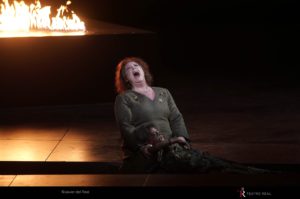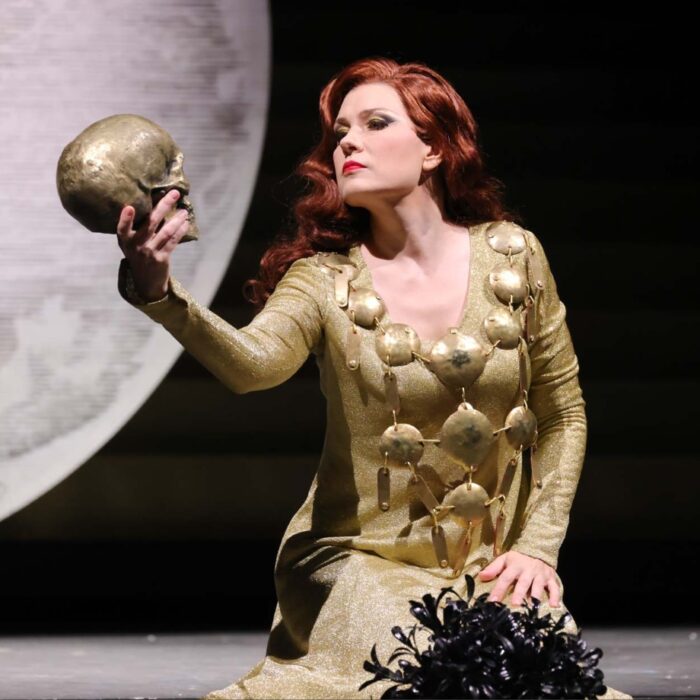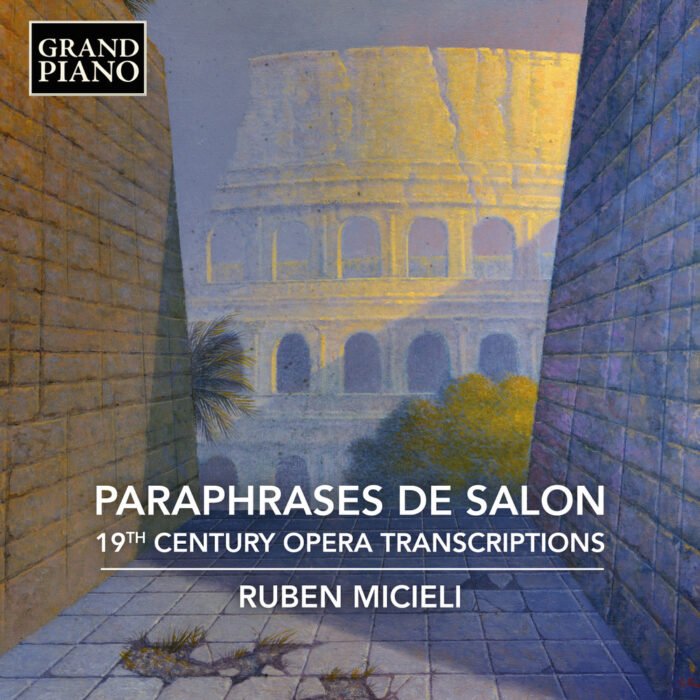
Teatro Real De Madrid 2018-19 Review: Il Trovatore
Ekaterina Semenchuk, Maria Agresta Lead A Tremendous Cast In Verdi’s Monumental Melodrama
By Mauricio VillaThe opera “Il Trovatore,” along with “La Traviata” and “Rigoletto,” makes up what is often called the “Verdi trilogy,” the trio of operas that mark the breakout for the composer and a shift toward operas where he looked for a communion between the drama and the music through new musical language and deep characterization of the roles.
“Il Trovatore” has one of the most melodramatic of plots in which a soprano mistakes her lover for her hated suitor (something that works very well in comedies like “Le nozze di Figaro” but not if you want to produce a believable tragedy), a woman that burns her son alive by mistake, etc. It has all the clichés of the worst bel-canto operas and melodramas.
But “Il Trovatore” has always been in the repertoire because of Verdi’s music. He managed to give the audience the bombastic chorus and bravura caballettas they were used to but broke completely with the structure of its time, particularly in how it draws Azucena’s character. Verdi also created tremendous dramatic effects throughout, including a wondrous intertwining the nun chorus with the voice of Count di Luna and his soldiers at the end of Act two.
There were nearly two years between the premiere of “Rigoletto” in 1851 and the first performance of “Il Trovatore” in 1853; Verdi enjoyed financial stability during this time and had no need to compose by command. It is the main reason why Verdi, with ample time at his disposal, turned this impossible story into an amazing opera.
“Easy to Stage”
There is an old saying that this opera is is easy to stage, as long as you have the four best singers in the world. Of course that is a bit misleading. Though the role of Manrico is often seen as one for a heavier tenor, I would argue that it is far from the challenging roles for tenor in such operas as “Aida,” “La “Forza del Destino,” or “Otello. It lies in the middle register and rarely goes higher than A natural; moreover the orchestra density is not as big as it is in the other operas just mentioned. So, the role has been made much more difficult that it was intended, especially if you look for a spinto or dramatic tenor who can sing the high C’s successfully.
However, the roles of Leonora, Count di Luna and Azucena are extremely demanding as they required a full vocal range from the lowest to the highest, impossibly long legato phrases (most of the time in the upper register), insane coloratura, and big dramatic voices able to portrayed strong emotions of passion, love, hate and regret.
Fortunately, the Teatro Real managed to gather a good team of singers divided into three casts to perform the 14 performances that concluded the opera season in Madrid.
Teatro Real presented a new production, in collaboration with the Montecarlo Opera and Royal Danish Opera directed by Francisco Negrin. The staging is centred in the character of Azucena (we have to consider that Verdi wanted to name the opera after the gypsy), the continuous presence of the ghost of her burned mother and the child she burned, and fire. The idea is good, with a clever use of flashbacks and having Azucena present on stage for most of the performance as well as a small flame at the front of the stage, the idea is faithful to the story and the music.
But it has some major problems. The sets designed by Louis Desiré present a big grey box (looks like concrete) with a balcony all around at stage level, and two platforms at the front and back of the stage that rise up and down; there is also a column which moves from side to side. The white and direct illumination by Bruno Poet gave a strong sense of coldness that crashes with the idea of fire, darkness and death that they intended to tell. The ghosts of the mother and the child, with a gory makeup that recreated the look of burned bodies appeared so frequently as to lose their impact. After one hour you had seen it all and their actions for the remainder were more of the same.
And then we have those unexplained and incomprehensible things that modern directors do, like presenting the male chorus as zombies or ghosts; Ferrando telling the story of the gipsy to a bunch of children as the chorus is relegated to the galleries around the stage or creeping on the floor; and a strange metaphorical use of a rope during the final scene which looked nice but does not make any sense.
It is a pity that having enjoyed greatest productions from Robert Carsen, David Alden or Laurent Pelly, the season ended with such a poor production of such a great title.
Missing the Heroic Moment
Francesco Meli sang the title role. He has a warm voice, with squillo and voluminous richness. However, his natural timbre is overshadowed by a slow vibrato when he sings above the passagio ( from G). The resolution of some high notes ended with a blow of air and the closing of the glottis, and he has a tendency to use portamenti or appoggiatura to attack some notes rather than going straight for the tune.
In summary, his voice is becoming too heavy for him to control and he is pushing the sound, probably paying for taking spinto roles too early. He is not even 40-years-old and this is not a normal development of the voice. You could very easily hear the difference in his timbre from the middle to the higher register. There is still a callback to his bel-canto past when singing legato and dynamics like the crescendo-diminuedo that he did in the G of “al core” right before his aria in Act three. However, his singing always featured uneven results if the phrases where written above the stave.
Fortunately the role of Manrico spends a lot of time in the middle register. If we look at the score, only a single B flat is written and it is in oppure; all the other high notes have been added by tradition.
He began his performance with a perfect ballad off-stage “Deserto sulla terra,” followed by the terzetto that ends the first act with an agile well-placed voice and easy high notes; this part is probably the highest for the tenor in the whole opera and it is usually performed at a fast tempo (though it was not the case under Benini’s hand). This made Meli lighten his sound with the vibrato becoming more natural and the sound less strained.
The highlight of Meli’s performance was the aria “Ah si, be mio” which he sang with exquisite delicacy; it is Manrico’s most lyrical moment and when Meli focuses on the vocal line, his voice seems more controlled.
Unfortunately, this performance was not on that same level during the famous cabaletta “Di quella pira;” he was probably carried away by the emotion of the piece, and he putting too much energy into it without attention to appropriate breath support and vocal placement. As soon as he started I knew that he would not be able to handle the high notes (in this case two B naturals as he lowered the key one semitone); the first high B on “O teco almen” was hoarse and tense, and the ending “all’armi” was short and strained ( in latter performances he avoided the first high B natural singing the phrase as written).
In spite of his problems with some high notes and some unpleasant sounds, Meli defended his character bravely proving to be a strong actor and agile enough for sword fighting and jumping over the sets.
Completing The Triangle
The Italian soprano Maria Agresta interpreted Leonora. If a soprano can sing lyrical or spinto parts like Desdemona, Mimì or Marguerite, as well as operas like “Norma,” “Anna Bolena” or “I puritani,” it means that she likely has the perfect voice for this Verdi role. This is undeniably the case with Agresta.
She has a dark timbre voice, modest in volume but well-projected with a clean coloratura, exciting high notes and an astounding ability to sustain piannissimi even in her highest notes. If there is a musical phrase that explains what a “legato Verdi phrase is” that would be: “Sei tu dal ciel di sceso, o in ciel son io con te” that Leonora sungs in Act two; Agresta’s rendition was strikingly moving and beautifully.
Leonora’s two arias “Tace la note” and “D’amor sull’ali rose” are built on a continuous ascending long legato phrases culminating in high notes. Here, Agresta interpolated a soft high D flat on the cadenza of her first aria and sang the high C and B flats with pianissimi phrasing during her second one.
She has a tendency to attack high notes directly and that was an obstacle in the phrase “Deh! Non dir gli improvvido” as the ascension from A flat to high C is written in legato and she cut the phrase to attack a perfect pianissimi high C. It is a shame that she did not perform the high D flat and chose the oppure version ( I have never heard the original written line sung live on stage) as she proved to have easy high notes; one might guess that this line must be extremely difficult as is rarely sung in performances.
Agresta’s voice was also strong and menacing enough to confront the caballetas, the “Miserere,” and her duet with Count Luna in Act four, all of which demand bravura attacks and strong high notes as well as a resonant middle and lower registers.
The voice of the French baritone Ludovic Tézier has considerably grown in volume. He still maintains his superb phrasing and effortless high notes, but his voice is developing the ideal Verdi timbre, volume, and legato singing. The Count di Luna is probably the highest role Verdi wrote for a baritone, and even if the role does not goes higher than G natural, the general tessitura of his interventions are extremely high for a baritone (singing constantly between F and F sharp). The role demands a lot of bravura and aggressiveness in such passages as the Terzeto at the end of Act one or his cabaletta “Per me ora fatale;” this of course requires a singer that is capable of expressing the big emotions with solid vocal control, something that Tézier amply displayed. He never needed to push the sound to be heard over the chorus and orchestra to transmit such explosive strong feelings.
Verdi composed the most beautiful baritone aria ever written for Count di Luna with “Il balen del suo sorriso.” It relies on never-ending legato phrases, full of dynamics and pianissimi and some of them culminating in high notes. Tézier did not disappoint, giving a delicate and profound performance which was celebrated by the audience during the opening night performance.
Tender & Violent Alike
Azucena was portrayed by the Russian mezzo-soprano Ekaterina Semenchuk who managed, as her colleagues Agresta and Tézier, to sing this impossible role with an unusual facility and was completely devoted to the dramatic characterization of her role. Azucena’s role demands everything from the singer, with an extreme tessitura that goes from low A to high C, features moments of outburst and anger which require a big vibrant voice, as well as moments of tenderness that requires soft singing and delicacy. It is really difficult to be able to succeed in all these tasks, but Semenchuk was impressive.
Beginning with the aria “Stride la vampa!” which has a contralto tessitura centred on the lower part of the voice, Semenchuk displayed the tragedy of the character with a resonant, menacing high G’s and incredibly powerful low notes. The Mezzo switches to the chest register when going lower than E; while it is true that this makes a big change in her timbre and creates unevenness in her voice, the volume and projection of her low notes is mesmerizing.
The tessitura remains extremely low for the first part of her duet with Manrico, but then Verdi wrote a high A natural followed by a high B flat on the phrase “mio figlio avea bruciato! Ah!,” and a high C in the cadenza of the line “spremi dal cor.” It is nearly a miracle that after such insistence and volume in the lower register Semenchuk can reach all the high notes effortlessly. She colored her phrases differently during the several repetitions of “mi vendica,” and displayed glorious mezza voce and piannisimi in “Ai nostril monti” in Act four. Finally, her climatic high B flat during “ sei vendicata, oh madre” at the close of the opera was everything you could have asked for, and more.
And her vocal talents were only amplified by her excellent portrayal of a schizophrenic mother being pushed constantly by strong emotions and the presence of the ghost of her dead mother and son. Semenchuk showed no hesitance in moaning, sobbing or laughing, providing a frightful and moving interpretation of the tormented gypsy. She deservedly received the greatest ovation at the curtain call.
Roberto Tagliavini was perfect in the short but nonetheless important role of Ferrando (he is in charge of the first scene of the opera where he narrates the story of the gypsy and the Count di Luna’s sons) singing the 14 performances with his imposing bass voice.
Maurizio Benini was inclined to slow tempi. I am sure that some singers were thankful for this, especially in their caballetas and strettas, but it made the action slow and heavy. He cut all repetitions of verses in arias and caballettas, yet managed to make the entire performance two hours and 20 minutes, something most conductors achieve when playing the complete score. In spite of this, he managed to create moments of tension and big orchestral density in the climax moments.
The intervention of the chorus of Teatro Real was also special, particularly the male section which has more weight in this opera. It was regrettable that the stage director placed most of the chorus on the balconies at the side of the stage during the famous “gypsy chorus” in Act two as their sound were completely swallowed up by the orchestra.
Ultimately, it was an amazing cast of singers ( I am obligated to mention Piero Pretti who sang Manrico with the “Pira” in the original key and a never ending high C at the end; and the baritone Artur Rucinski who is able to sing very long phrases on a single breath) with an inspired production but poor results.


